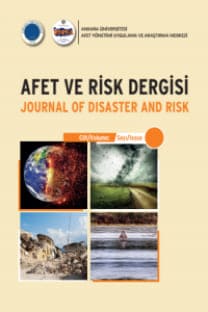Üniversite Öğrencilerinde Afet Farkındalık Eğitimi Etkinliğinin Değerlendirilmesi
Afet, Afet Farkındalığı, Afet Farkındalık Eğitimi, Üniversite Öğrencileri
Evaluation of Disaster Awareness Education Efficiency in University Students
___
- Adiyoso W, Kanegae H (2012). Theeffect of different disaster education programs on tsunami preparedness among school children in Aceh, Indonesia. Disaster Mitigation of Cultural Heritage and Historic Cities, 6(1), 165-172.
- Akçil Ö (2011). Development and explorıng the effectiveness of the revised version of basic disaster awareness. Master Thesis, Training Program DesignedIn A Non-Formal Science Learning Environment Graduate Program in Secondary School Science and Mathematics Education, Boğaziçi University
- Arslan E (2016). Trakya Üniversitesi Tıp Fakültesi öğrencilerinin afet-acil durumlar hakkında bilgi tutum ve davranışlarının değerlendirilmesi (Yayınlanmamış Uzmanlık Tezi). Trakya Üniversitesi Tıp Fakültesi Acil Tıp Anabilim Dalı, Edirne.
- Avcı S, Kaplan B, Ortabağ T (2020). Hemşirelik bölümündeki öğrencilerin afet konusundaki bilgi ve bilinç düzeyleri. Resilience, 4(1), 89-101. DOI: https://doi.org/10.32569/resilience.619897
- Büyüköztürk Ş, Çakmak EK, Akgün ÖE, Karadeniz Ş, Demirel F (2017). Bilimsel araştırma yöntemleri. Pegem Atıf İndeksi, 2017, 1-360.DOI: 10.14527/9789944919289
- Codreanu TA, Celenza A, Jacobs I (2014). Does disaster education of teenagers translate into better survival knowledge, knowledge of skills, and adaptive behavioral change? A systematic literatüre review. Prehospital and Disaster Medicine, 29(6), 529-642. DOI:10.1017/S1049023X14001083
- Der Heide EA (2006). Theimportance of evidence-based disaster planning. Annals of emergency medicine, 47(1), 34-49. DOI:10.1016/j.annemergmed.2005.05.009
- Gerber B L, Cavallo AM, Marek EA (2001). Relationships among informal learning environments, teaching procedures and scientific reasoning ability. International Journal of ScienceEducation, 23(5), 535-549. DOI: 10.1080/09500690116971
- Hungerford HR, Volk TL (1990). Changing learner behavior through environmental education. The journal of environmenta leducation, 21(3), 8-21.DOI:http://dx.doi.org/10.1080/00958964.1990.10753743.
- Dierking LD, Falk JH, Rennie L, Anderson D, Ellenbogen K (2003). Policy statement of the “informal science education” ad hoc committee. Journal of research in science teaching, 40(2), 108-111.DOI 10.1002/tea.10066
- Hoffmann R, Muttarak R (2017). Learn from the past, prepare for the future: Impacts of education and experience on disaster preparedness in thePhilippines andThailand. World Development, 96, 32-51. DOI: http://dx.doi.org/10.1016/j.worlddev.2017.02.016
- Karakuş U, Önger S (2017). 8. Sınıf Öğrencilerinin Doğal Afet ve Afet Eğitimi Kavramını Anlama Düzeyleri/The Understanding Levels on Natural Disasters and Disasters Education Concepts for 8th Grade Students Students. Journal of History Cultureand Art Research, 6(6), 482-491.doi:http://dx.doi.org/10.7596/taksad.v6i6.1247.
- Karanci AN, Aksit B, Dirik G (2005). Impact of a community disaster awareness training program in Turkey: Does it influence hazard-related cognitions and preparedness behaviors. Social Behavior and Personality, 33(3), 243-258.DOI:10.2224/sbp.2005.33.3.243.
- Kırıkkaya BE, Gerdan S. (2019). Afet farkındalık ölçeği (afö) için geçerlik ve güvenirlik çalışması. Uluslararası Marmara Fen ve Sosyal Bilimler Kongresi (Bahar) 2019 Bildiriler Kitabı (Sosyal Bilimler). Ss. 388-395.
- Kundak S. (2018). Şehirler, Afetler ve İnsan, http://dosya.toprakisveren.org.tr//makale/2011-92-sedakundak.pdf. (Son Erişim 12.06.2022)
- Mishra S, Suar D. (2012). Effects of anxiety, disastere ducation, and resources on disaster preparedness behavior. Journal of Applied Social Psychology, 42(5), 1069-1087.DOI:10.1111/j.1559-1816.2011.00853.x
- Muttarak, Pothisiri W. (2013). The role of education on disaster preparedness: casestudy of 2012 Indian Ocean earthquakes on Thailand’s Andaman Coast. Ecology and Society, 18(4).DOI:10.5751/ES-06101-180451
- Oguz A. (2005). Surveying* American and Turkish middle school students' existing knowledge of earthquakes by using a systemic network. The Ohio State University.
- Reissman DB, Howard J. (2008). Responder safety and health: preparing for future disasters. Mount Sinai Journal of Medicine: A Journal of Translational and Personalized Medicine: A Journal of Translational and Personalized Medicine, 75(2), 135-141.DOI:10.1002/msj.20024
- Ronan KR, Johnston DM (2003). Hazards education for youth: A quasi‐experimental investigation. Risk Analysis: An International Journal, 23(5), 1009-1020.DOI:10.1111/1539-6924.00377
- Şahin Y, Lamba M, Öztop S (2018). Üniversite öğrencilerinin afet bilinci ve afete hazırlık düzeylerinin belirlenmesi. Medeniyet Araştırmaları Dergisi, 3(6), 149-159.
- URL-1: Ruben Geertvan den Berg under (2021). How to Get (Partial) Eta Squared from SPSS? https://www.spss-tutorials.com/spss-partial-eta-squared/ (Son Erişim 07.12.2022)
- Yayın Aralığı: 4
- Başlangıç: 2018
- Yayıncı: Ankara Üniversitesi
Göçün Kent Estetiği Üzerine Etkisi
Reflection of COVID-19 in The Context of Posttraumatic Growth in Turkish Society
Çağla YİĞİTBAŞ, Ayse ELKOCA, Handan ÖZCAN
Deprem Sonrası İlk Durak: İstanbul’da Toplanma Alanlarına Dair Bir İnceleme
Afet Yönetimi Odağında Orman Yangınlarının Değerlendirilmesi
Kimyasal, Biyolojik, Radyolojik, Nükleer (KBRN) Olaylarında Sağlık Okuryazarlığı
Ayşe Handan DÖKMECİ, Ege DENİZ
Kırılgan Gruplar Özelinde Afetlerde Psikososyal Hizmetler
Fatih ARICA, Cevahir ÇAKIR, Dilek KAĞNICI
